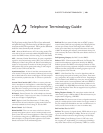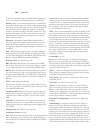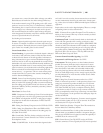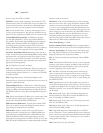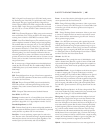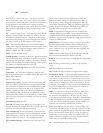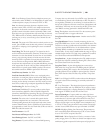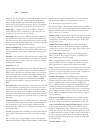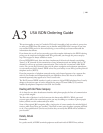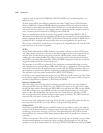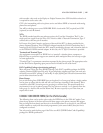110 | Appendix 2
interfaces to the telephone network. In some circles ‘PBX’ implies
a manual switchboard whereas ‘PABX’ (Private Automatic branch
exchange) implies a PBX that supports dialing by end users.
Many PBX’s can now offer ISDN BRI service, usually over the S
Interface. A few vendors are now offering BRI over the U interface
as well. PRI over DSX-1/T1 or E1 is also offered in some cases. Be
wary of these ISDN protocols since they have not been as well tested
as the versions running on “public” switches. ey may or may not
work with a given piece of CPE.
PIC- Primary Interexchange Carrier. (USA) is is your default “1+”
carrier used for interLATA calls. In some areas you may have two
PICs, one for interLATA calls, and one for intraLATA long distance
calls (in which case it stands for Primary Intraexchange Carrier). In
some areas intraLATA long distance calls are still handled by your
RBOC, in others you now have a choice. You may be able to discover
who you current PIC is by dialing 700 555-4141.
PMP (USA) - AT&T “Custom Point to Multi-Point” Custom
ISDN Protocol. Not supported by the Zephyr or ZephyrExpress.
See Custom ISDN and ISDN Protocol.
POP - Point Of Presence. e local facility where your IEC main-
tains a switch. is is where your long distance calls get routed so
that your IEC can handle them. Also used to describe the local access
point of an Internet Service Provider.
POT- Plain Old Telephone. A black, rotary-dial desk phone. Usually
a Western Electric model 500 set. Outdated term.
POTS – Plain Old Telephone Service. Regular old-fashioned analog
loop start phone service.
PRI – ISDN Primary Rate Interface- A form of ISDN with 23
“B Channels” and one “D channel”. All 24 channels are on a single
cable. Functionally related to T1 telephone circuits. In Europe PRI
has 30 “B Channels” and one “D Channel” and one “Sync channel”.
See also B channel and D channel.
Provisioning -e act of configuring an ISDN or other telecom-
munications path. Also refers to the complete line configuration
information.
PS2 Power - Power provided on pins 7 and 8 of the “S” interface
cable. is power is used so that a NT1 can provide power to a ter-
minal (usually a phone). In some cases, it is used to allow a terminal
to power an NT1. e USA versions of the Zephyr and ZephyrEx-
press supply PS2 power in the “S” jack. e Zephyr Xstream and
Telos TWO provide this on all versions. is power arrangement is
also used in the Telos TWOx12 and 2101 Studio Interface to power
Desktop Directors.
PTP (USA)- AT&T “Custom Point to Point” Custom ISDN Pro-
tocol. Point-to-Point lines have only one incoming phone number
which must be dialed twice to connect to both lines (the first call
goes to “line 1” and the second call rolls over to “Line 2”. See Cus-
the street” who compare the coded audio to the original and grade
the relative quality.
MSN/DN 1&2 (Zephyr Xstream)- e Telco menu selections on
the Xstream where the MSN (Euro & INS 64 ISDN) or 7 digit
Directory Numbers (USA ISDN) can be entered during set up. e
Zephyr Xstream generally does not require that these numbers be
present. See Directory Number and MSN.
MSN- Multiple Subscriber Number (Euro ISDN). is is a
telephone number associated with an ETS 300 BRI line. Provid-
ers of ETS 300 often give you three MSNs with a BRI, although
additional MSNs can be purchased. An ISDN terminal will “ring”
(provide an alerting signal) only when calls are made to the MSN
(or MSNs) entered in that terminal. If a terminal has no MSNs
entered, it will “ring” whenever there is a call to any of the MSN’s
on that BRI. See ETS 300 and DN.
National ISDN (USA & Canada)- e US “standardized” multi-
platform ISDN protocol. e first version is National ISDN-1. As
of mid 1996 National ISDN-2 has been implemented in some areas
and is fully backward compatible with National ISDN-1.
NCTE – Network Channel Terminating Equipment. NCTE is a
general term that can be applied to a CSU or NT1 or other equip-
ment terminating a digital line at the customer’s premises. In many
countries, the NCTE is provided by the Telco. e USA is not one
of those countries.
Network Channel Terminating Equipment. See NCTE.
Network Termination - See NT
Nortel- Manufacturer of the DMS-100 switch as well as many
other pieces of telecom and network equipment. Now called Nortel
Networks.
NT - Network Termination - e electrical and protocol specifica-
tions for the user end of an ISDN line. See also LT.
NT-1- An alternative expression for NT1. See NT1
NT1- Network Termination Type 1. e termination at the
customer premises of an ISDN BRI circuit. e NT1 performs the
role of line termination of the “U” interface and Codes/Decodes
from the line’s 2B1Q coding scheme. e customer end of the NT1
interfaces using the “S” or “T” interface. e NT1 is frequently
part of the “Terminal Adapter” and is built-in to Zephyr Xstream,
Zephyr, ZephyrExpress, Telos TWO and TWOx12 systems sold in
the USA & Canada. See also NCTE
NTBA- Network Termination Basic Access. e term used for
NT1 in some countries. See NT1. See also NCTE.
OOS – Out of Service. An alarm light or condition on a T1 or
trunk.
PBX- Private Branch Exchange. A privately owned switch. Basi-
cally, a PBX is a private “business” telephone system which also




